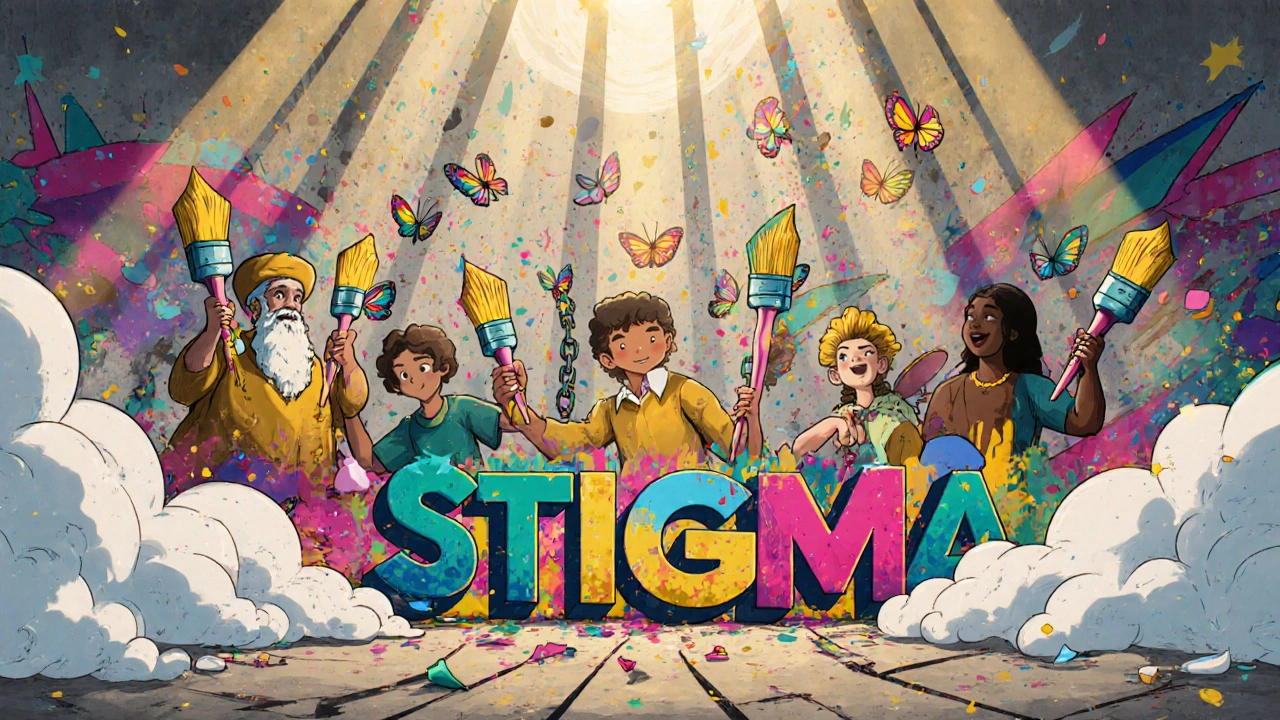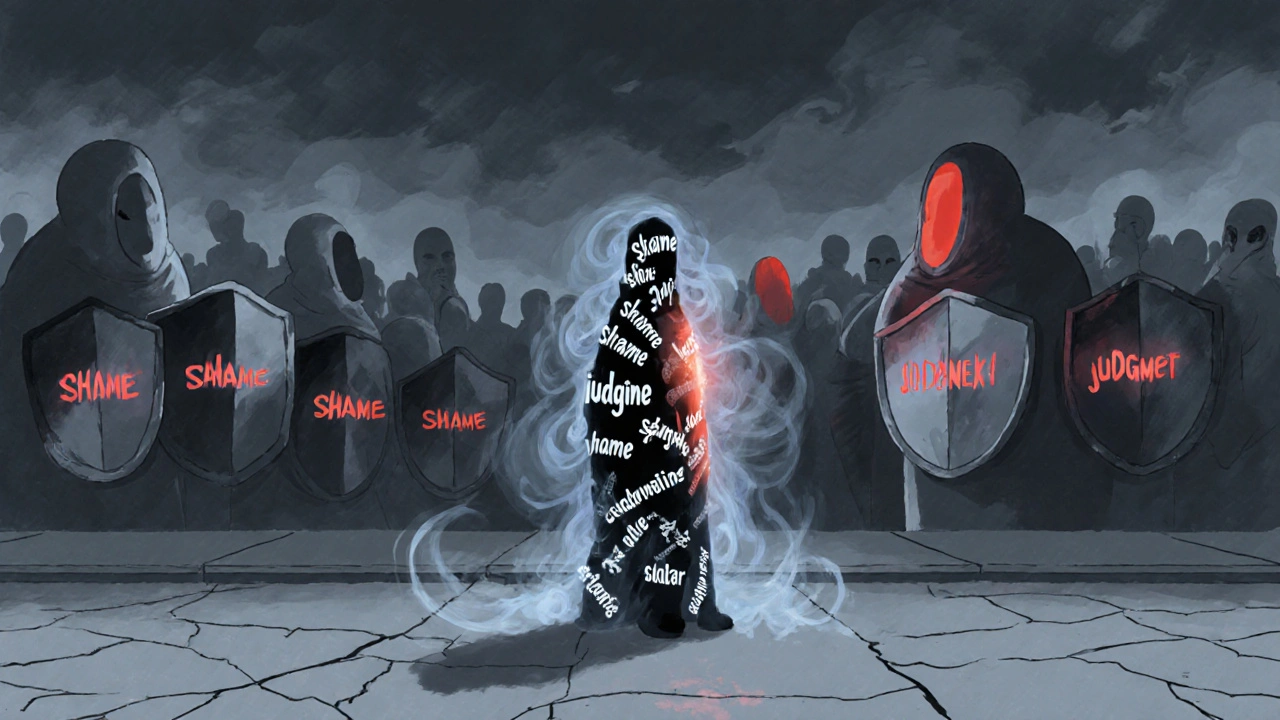Syphilis Symptom Assessment Tool
Check Your Symptoms
This tool helps you identify potential syphilis symptoms and understand what to do next. Remember: early detection leads to quick treatment and prevents serious complications.
Your Assessment
Next Steps:
- Get tested immediately at a local health clinic or pharmacy
- Follow up with a healthcare provider for accurate diagnosis
- Keep your results confidential - this is not a judgment
- Early treatment cures >95% of cases with a single dose
When discussing Syphilis is a bacterial sexually transmitted infection caused by Treponema pallidum, the conversation often veers into fear and judgment. Add to that the weight of Stigma - a social label that marks any condition as shameful - and you get a perfect storm that keeps people from seeking help.
What Is Syphilis?
Syphilis progresses through three stages: primary, secondary, and tertiary. Each stage shows different symptoms, from painless sores to rash to organ damage. The infection spreads through sexual contact and, in rare cases, from mother to child during pregnancy. Untreated syphilis can lead to irreversible neurological damage, heart problems, and even death.
According to the World Health Organization (WHO), there were an estimated 7.1 million new cases worldwide in 2023, a rise driven largely by reduced testing during the COVID‑19 pandemic.
How Stigma Forms
Stigma isn’t just an abstract feeling; it’s shaped by cultural narratives, media portrayals, and historical misconceptions. In the early 20th century, syphilis was linked to moral failing, leading to harsh laws and public shaming. Those echoes linger today, especially in communities where sexual health is a taboo topic.
Key drivers include:
- Lack of accurate information - myths about transmission and morality still circulate.
- Religious or cultural beliefs that label sexual activity outside marriage as immoral.
- Media sensationalism that portrays STIs as punishments.
- Personal experiences of discrimination when disclosing a diagnosis.
Impact of Stigma on Treatment
When someone fears judgment, they delay testing, hide symptoms, or avoid medical facilities altogether. A 2022 study by the Centers for Disease Control and Prevention (CDC) showed that 34 % of surveyed adults with syphilis symptoms waited more than three months before seeing a doctor.
Delays increase the risk of severe complications and raise community transmission rates. Stigma also undermines partner notification - a proven method to curb spread - because people are reluctant to disclose their status.

Breaking Down the Barriers
Addressing syphilis stigma requires a multi‑layered approach that tackles individual fears, community norms, and health‑system practices.
1. Education That Respects Privacy
Clear, jargon‑free facts about how syphilis is transmitted, treated, and prevented empower people to act. Online modules that let users learn anonymously have higher completion rates than public seminars.
2. Normalizing Testing
Make testing as routine as checking blood pressure. Free rapid tests in pharmacies, university health centers, and community hubs reduce the “special‑clinic” stigma.
3. Safe Disclosure pathways
Offer confidential counseling services that help patients practice how to tell partners. Digital tools that generate anonymous notification messages have cut partner‑delay times by 40 % in pilot programs.
4. Provider Sensitivity Training
Healthcare workers need training to avoid judgmental language. Empathy‑focused workshops improve patient satisfaction scores by 22 % and increase follow‑up appointment adherence.
5. Community‑Led Campaigns
When trusted local figures - such as religious leaders, youth mentors, or LGBTQ+ advocates - share accurate messages, the community’s perception shifts faster than top‑down government messaging.
Practical Steps for Individuals
- Know the symptoms: painless ulcer (primary), rash on palms/soles (secondary), neurological signs (late).
- Get tested at least once a year if sexually active with new partners.
- If you test positive, remember that a single dose of Penicillin cures early‑stage syphilis in >95 % of cases.
- Inform recent sexual partners promptly - use anonymous notification services if needed.
- Follow up with a repeat test three months after treatment to confirm cure.

Community Strategies
Local health departments can launch Public Health Campaigns that combine social media clips, street art, and pop‑up testing booths. The 2024 Sydney “Know Your Status” event reached 12,000 people and saw a 30 % rise in testing appointments.
Partner tracing programs, when paired with privacy safeguards, can identify up to 1.8 contacts per index case, dramatically lowering outbreak potential.
Policy and Healthcare Approaches
Governments should ensure free or low‑cost testing, especially for marginalized groups. Insurance coverage must include the full course of antibiotics and follow‑up visits.
Data collection standards need to protect identity while allowing public health officials to monitor trends. De‑identified dashboards help allocate resources without exposing individuals.
Key Takeaways
- Syphilis is curable, but stigma blocks timely care.
- Accurate, private education reshapes misconceptions.
- Routine, accessible testing normalizes the process.
- Empathetic healthcare interactions encourage disclosure.
- Community leaders and policy makers play critical roles in dismantling barriers.
What are the early signs of syphilis?
The first sign is usually a small, painless sore called a chancre, appearing at the spot where the bacteria entered the body. It heals on its own in 3-6 weeks, but the infection remains.
Can syphilis be cured with a single dose of medication?
For early‑stage syphilis, a single intramuscular injection of penicillin is enough in more than 95 % of cases. Late‑stage disease may require multiple doses.
How does stigma affect partner notification?
Stigma makes people hesitant to tell partners, delaying treatment for those contacts. Anonymous notification tools can reduce that hesitation and improve tracing rates.
Where can I get a free syphilis test?
Many community health clinics, pharmacies, and university health centers offer free rapid tests. Local public‑health hotlines list the nearest locations.
Is syphilis transmission possible without sexual contact?
Yes, a mother can pass the bacteria to her baby during pregnancy or birth, leading to congenital syphilis. Non‑sexual transmission between adults is extremely rare.


Kimberly Lloyd
Hey folks, it’s amazing how a little knowledge can dissolve a mountain of shame. When we see syphilis as just a medical thing, not a moral judgment, it opens the door to compassion. Think of it like a broken vase – you don’t toss it away, you fix it and keep it on the shelf.
Sakib Shaikh
Yo, you gotta realize the facts: syphilis spreads through direct contact, not through karma or random vibes. The penicillin shot is a game‑changer, bro, it wipes out early stages like a boss. If you’re scared of stigma, just remember the science doesn’t care about your reputation – it just wants to kill the bug.
Devendra Tripathi
Stigma is just fear in fancy clothes.
Nick M
They don’t tell you that the pharma giants profit from keeping people scared. Every time a test is hidden behind a clinic door, someone’s data gets logged for… something. And why do we always hear “just get tested” while the government watches?
eric smith
Oh, look, the grand conspiracy again – as if the CDC would hand out free tests just out of the kindness of their hearts. Maybe they’re just bored and needed a hobby.
Jake Hayes
The data is clear: stigma reduces testing rates. If you want higher numbers, reduce the moral panic.
parbat parbatzapada
Sure, but every “clear data” set comes from labs that are secretly run by shadow groups. Don’t be surprised if the “education” you get is a script.
Casey Cloud
Quick tip: many pharmacies now have rapid tests that give results in 15 minutes. No appointment needed just walk in and you’re done. Also, most insurance covers it if you ask for the code‑share form.
Rachel Valderrama
Wow, because a little sarcasm will totally stop the spread – love the enthusiasm though.
Eli Soler Caralt
Ah, the age‑old dance of ignorance and ego 🕺💃. If only we could sprinkle some pseudo‑philosophy on the stigma, maybe it’d melt away like butter on toast. 😂
Eryn Wells
Let’s be inclusive: everyone deserves a safe space to learn and get tested. 🌈 Reach out to your local community centre – they often host pop‑up clinics.
Kathrynne Krause
Time to turn the narrative upside down! Imagine a world where getting a syphilis test is as routine as grabbing a coffee. We can make that happen if we keep talking, keep supporting, and keep laughing at the absurdity of shame.
Jasmina Redzepovic
Our nation’s health is at stake, and we can’t let foreign propaganda dictate our policies. Free testing must be a patriotic duty, not a charitable afterthought.
Ivan Laney
First of all, the assertion that free testing is merely a “charitable afterthought” completely ignores the economic incentives that underpin public health initiatives in any sovereign nation; when the government allocates resources toward widespread screening, it is effectively investing in a healthier workforce, which in turn bolsters productivity and reduces long‑term medical expenditures across the board.
Second, the notion that foreign entities are somehow orchestrating a stigma campaign to sabotage national health outcomes is a classic diversionary tactic that ignores the extensive epidemiological data showing that stigma is a locally rooted social construct, often reinforced by cultural narratives rather than external meddling.
Third, the emphasis on “patriotic duty” should not be conflated with nationalist rhetoric that seeks to marginalize minorities; true patriotism embraces all citizens, providing equitable access to diagnostics regardless of socioeconomic status.
Fourth, the practical implementation of free testing requires a coordinated effort between federal agencies, local health departments, and community organizations, each bringing unique expertise to ensure accessibility and confidentiality.
Fifth, studies have demonstrated that anonymity in testing-through pharmacy kiosks or mobile units-significantly increases uptake, as individuals feel protected from potential discrimination.
Sixth, integrating education with testing, such as distributing pamphlets that debunk myths about transmission, has been shown to improve health‑seeking behavior by up to 27% in pilot programs.
Seventh, partner notification tools that preserve anonymity can bridge the gap between personal privacy and public health imperatives, facilitating quicker treatment of contacts.
Eighth, training healthcare providers in non‑judgmental communication not only improves patient satisfaction but also boosts adherence to follow‑up appointments, a crucial factor in confirming cure.
Ninth, policy frameworks should mandate coverage of both the initial antibiotic regimen and subsequent confirmatory testing to eliminate financial barriers that might deter individuals from seeking complete care.
Tenth, the deployment of digital dashboards that aggregate de‑identified case data enables timely resource allocation without compromising individual privacy.
Eleventh, community leaders-whether religious, youth, or LGBTQ+ advocates-play a pivotal role in reshaping perceptions, and their involvement should be formally supported through grant programs.
Twelfth, the long‑term success of any stigma‑reduction campaign hinges on sustained public education, regular accessibility audits of testing sites, and transparent reporting of outcomes.
Thirteenth, encouraging routine screening as part of standard sexual health check‑ups normalizes the process and reduces the “special‑clinic” stigma that many associate with STIs.
Finally, while the rhetoric of national pride can be a powerful motivator, it must be grounded in evidence‑based strategies that prioritize inclusivity, accessibility, and scientific integrity above all else.